
Luffness Castle, also known as Luffness House, is a house built in a former fortification near the village of Aberlady, East Lothian, Scotland.

Luffness Castle, also known as Luffness House, is a house built in a former fortification near the village of Aberlady, East Lothian, Scotland.
The lands around the current house were a part of the estates of the Gospatrick Earls of Lothian, but in the 12th Century they were given to the Lindsay family in marriage and this family constructed a castle on the site in the 13th century, this was described as a large and strong fortress. Some of the property was donated to the Church as a memorial to Sir David Lindsay, High Chamberlain of Scotland in 1256 and a Regent for Alexander III, who died on crusade which was under the leadership of Louis of France. On his deathbed Sir David promised to donate land for a religious house so long as his remains were returned to Scotland. A Carmelite friary was then built nearby in 1293 and remnants of the priory still exist overgrown within the woods. Edward I and an English army occupied the castle in 1311. It was sacked in 1547 by an English force under the command of Edward Clinton, Lord Clinton.
The English army treasurer and diplomat Ralph Sadler advised the Earl of Shrewsbury that a new fort at Aberlady would support an English garrison to be installed nearby inland at Haddington. There were also suggestions that an English fort should be built for this purpose at "White-castell" at Nunraw or on the "Pethes", a narrow route between hills in Scotland. [1]
French and Scots soldiers, directed by Paul de Thermes, built a fort here in 1549 to interrupt the English supply to their garrison at Haddington. [2] On 23 June 1549 Regent Arran summoned neighbouring villagers to fight off English soldiers trying to prevent the buildings work. On 25 June Arran requested the lairds of East and West Lothian to provide labourers. The royal treasurer's accounts refer to the "fort of Aberlady". Oxen dragged guns from the fort to the nearest harbour in January 1550 for shipping to Monifieth, to be used against Broughty Castle. [3] This fort was demolished on the orders of Marie de Guise in 1552.
In the second half of the 16th Century the ownership of Luffness was transferred to the Hepburn Earls of Bothwell who rebuilt the castle and in the 17th century the estate change ownership again to the Durham family while an Adam Duff of Luffness is recorded in 1704. In 1739 the Hope Earl of Hopetoun bought Luffness and in 1822 the castle and was altered and extended by William Burn with the further works carried out under the direction of David Bryce in 1846 and 1874. Today the house is well maintained, and is still occupied by the Hope family. [4]

Luffness House is presently a tower house of three storeys with an attic and it forms a T shape with the square turret forming its stem. There is a turnpike stair which occupies the first two floors. Nigel Tranter thought that this stair incorporated what was left of the castle, and is likely from the 13th century. [5] The house is situated at the northwestern angle of a square fortification which is delineated by a partially infilled ditch which may be a remnant of the French built fortifications from 1549, or it may be the remains of the earlier castle. [6]

East Lothian is one of the 32 council areas of Scotland, as well as a historic county, registration county and lieutenancy area. The county was also known as Haddingtonshire.
Broughty Castle is a historic castle on the banks of the River Tay in Broughty Ferry, Dundee, Scotland. It was completed around 1495, although the site was earlier fortified in 1454, when George Douglas, 4th Earl of Angus, received permission to build on the site. His son, Archibald Douglas, 5th Earl of Angus, was coerced into ceding the castle to the crown. The main tower house forming the centre of the castle with four floors was built by Andrew, 2nd Lord Gray, who was granted the castle in 1490.

Dunglass is a hamlet in East Lothian, Scotland, lying east of the Lammermuir Hills on the North Sea coast, within the parish of Oldhamstocks. It has a 15th-century collegiate church, now in the care of Historic Scotland. Dunglass is the birthplace of Sir James Hall, an 18th-century Scottish geologist and geophysicist. The name Dunglass comes from the Brittonic for "grey-green hill".
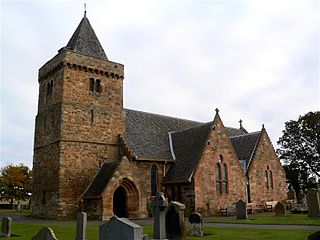
Aberlady is a coastal village in the Scottish council area of East Lothian. The village had an estimated population of 1,260 in 2020.

Dunbar Castle was one of the strongest fortresses in Scotland, situated in a prominent position overlooking the harbour of the town of Dunbar, in East Lothian. Several fortifications were built successively on the site, near the English-Scottish border. The last was slighted in 1567; it is a ruin today.

Crichton Castle is a ruined castle near the village of Crichton in Midlothian, Scotland. It is situated at the head of the River Tyne, 2 miles (3.2 km) south of the village of Pathhead, and the same distance east of Gorebridge.
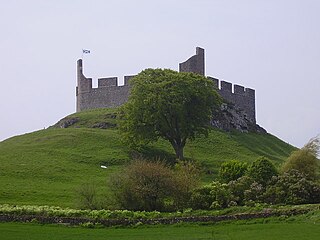
Hume Castle is the heavily modified remnants of a late 12th- or early 13th-century castle of enceinte held by the powerful Hume or Home family, Wardens of the Eastern March who became successively the Lords Home and the Earls of Home. The village of Hume is located between Greenlaw and Kelso, two miles north of the village of Stichill, in Berwickshire, Scotland.. It is a Scheduled Ancient Monument, recorded as such by Historic Environment Scotland.
Nunraw is an estate in East Lothian, Scotland. It includes the White Castle, a hillfort, situated on the edge of the Lammermuir Hills, two miles south of the village of Garvald, Nunraw House was formerly used as the Guesthouse for retreatants at Sancta Maria Abbey the Cistercian monastery on the hillside nearby. Sir James Balfour Paul, Lord Lyon King of Arms, writing in 1905 stated that Whitecastle and Nunraw are the same place and that the lairds there were often referred to by one or the other of these territorial designations.
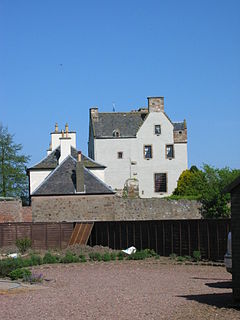
Ballencrieff Castle, also known as Ballencrieff House, is a large tower house at Ballencrieff, East Lothian, Scotland. It is located three miles north west of Haddington, and one mile south of Aberlady.
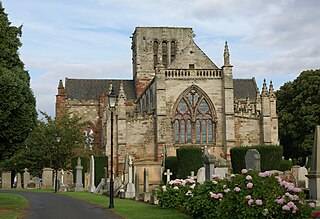
The Sieges of Haddington were a series of sieges staged at the Royal Burgh of Haddington, East Lothian, Scotland, as part of the War of the Rough Wooing, one of the last Anglo-Scottish Wars. Following Regent Arran's defeat at the battle of Pinkie Cleugh on Saturday 10 September 1547, he took Haddington, with 5000 troops including French mercenaries and troops sent by Henry II of France to bolster the Auld Alliance. Afterwards, Francis Talbot, 5th Earl of Shrewsbury took it with nearly 15,000. The English forces built artillery fortifications and were able to withstand an assault by the besieging French and Scots troops supported by heavy cannon in July 1548. Although the siege was scaled down after this unsuccessful attempt, the English garrison abandoned the town on 19 September 1549, after attrition by Scottish raids at night, sickness, and changing political circumstance.
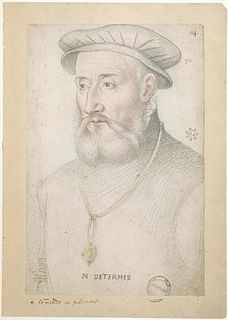
Paul de La Barthe de Thermes or de Termes (1482–1562), also Paul de Terme or Maréchal de Thermes, was a French Army Marshal ("Maréchal").

Saltoun Hall is an historic house standing in extensive lands off the B6355, Pencaitland to East Saltoun road, about 1.5 miles from each village, in East Lothian, Scotland. The house is reached by way of an impressive gateway and is situated at grid reference NT461685.

The Rough Wooing, originally known as the Eight Years' War, was part of the Anglo-Scottish Wars of the 16th century between Scotland and England. Following its break with the Roman Catholic Church, England attacked Scotland, partly to break the Auld Alliance and prevent Scotland being used as a springboard for future invasion by France, partly to weaken Scotland, and partly to force the Scottish Parliament to confirm the existing marriage alliance between Mary, Queen of Scots, and the English heir apparent Edward, son of King Henry VIII, under the terms of the Treaty of Greenwich of July 1543. An invasion of France was also contemplated. Henry declared war in an attempt to force the Scottish Parliament to agree to the planned marriage between Edward, who was six years old at the start of the war, and the infant queen, thereby creating a new alliance between Scotland and England. Upon Edward's accession to the throne in 1547 at the age of nine, the war continued for a time under the direction of the Duke of Somerset, before Somerset's removal from power in 1549 and replacement by the Duke of Northumberland, who wished for a less costly foreign policy than his predecessor. It was the last major conflict between Scotland and England before the Union of the Crowns in 1603.

Kinneil House is a historic house to the west of Bo'ness in east-central Scotland. It was once the principal seat of the Hamilton family in the east of Scotland. The house was saved from demolition in 1936 when 16th-century mural paintings were discovered, and it is now in the care of Historic Environment Scotland. The house now consists of a symmetrical mansion built in 1677 on the remains of an earlier 16th- or 15th-century tower house, with two rows of gunloops for early cannon still visible. A smaller east wing, of the mid 16th century, contains the two painted rooms. The house is protected as a Category A listed building.

Kilspindie Castle lies north of the village of Aberlady, in East Lothian, Scotland; the remains of the castle are behind the Victorian St Mary's Kirk. An early castle was destroyed in the 16th century, and the rebuilt tower was pulled down by the 18th century. Little more than a few scattered stones of the base of a doorway with a length of wall punctuated by oval gun loops remain. The area is protected as a scheduled monument. Another ruin called "Kilspindie Castle" was at Butterdean near Coldingham.

The siege of St Andrews Castle (1546–1547) followed the killing of Cardinal David Beaton by a group of Protestants at St Andrews Castle. They remained in the castle and were besieged by the Governor of Scotland, Regent Arran. However, over 18 months the Scottish besieging forces made little impact, and the Castle finally surrendered to a French naval force after artillery bombardment. The Protestant garrison, including the preacher John Knox, were taken to France and used as galley slaves.

Brunstane Castle is a ruined tower house, dating from the 16th century, around 2 miles (3.2 km) south-west of Penicuik, on the north bank of the North Esk, in Midlothian, Scotland.

Margaret Douglas, Countess of Arran and Duchess of Châtellerault was a Scottish aristocrat.
Dunglass Castle was formerly a castle at Dunglass in East Lothian, Scotland. It was a seat of the Home family and frequently visited by the Stewart kings. There are no upstanding masonry remains of the castle, but Dunglass Collegiate Church is maintained by Historic Environment Scotland.